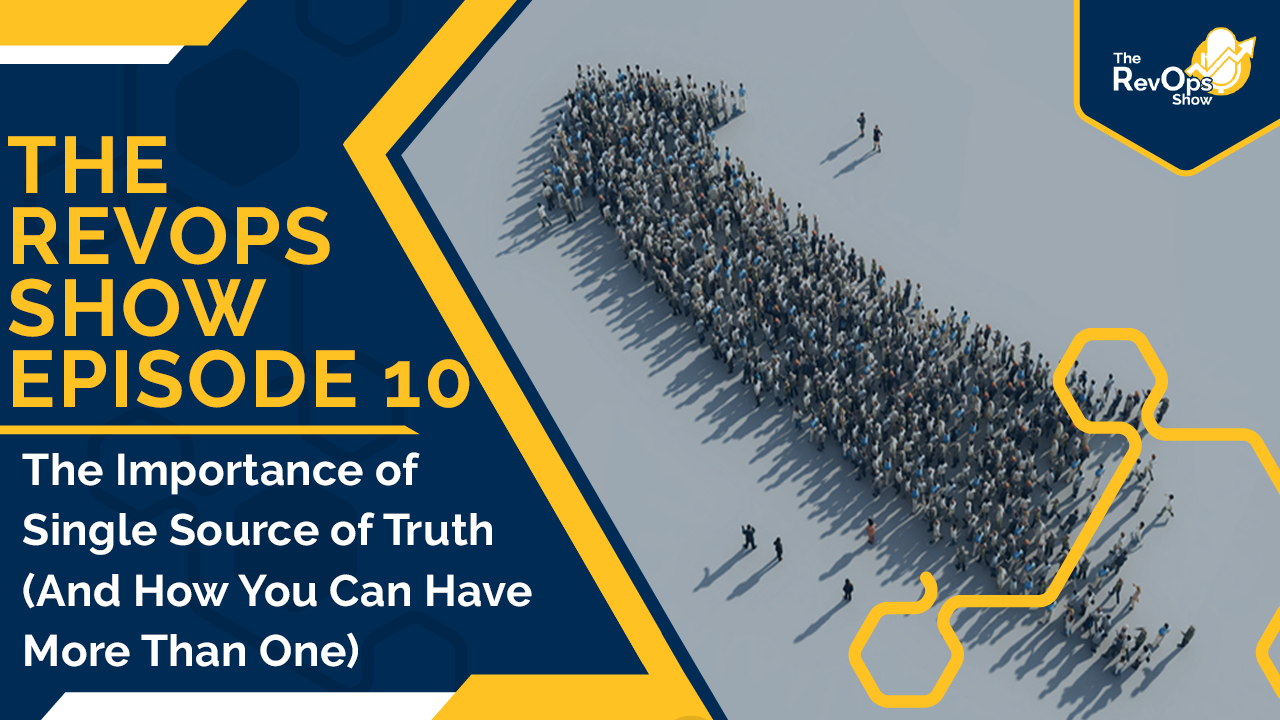The data based conversation we had in Episode 9: I've Got 99 Problems, But (After Listening to This Episode) Data Migration Ain't One got Jess thinking about single source of truth. With all kinds of integrations that are going on, there’s a lot of conversation around single source of truth and how important it is.
Audio:
Video:

Additional Resources:
- Episode 9: I've Got 99 Problems, But (After Listening to this Episode) Data Migration Ain't One
- Episode 2: KPIs Part 1 - The What, When, Where & Why of Key Performance Indicators
- Episode 3: KPIs Part 2 - 4 Common Scenarios & Where to Start
Show Notes:
Single source of truth gets thrown around a lot. So that we’re clear on what it means and what it is, what is single source of truth?
Doug thinks people focus on the word single more than they focus on source of truth. The source of truth is where the real information is, where the real data is, what’s right. Single source of truth is the north star of whatever it is you’re talking about. If we talk about aligning vectors, we’re all pulling to the same point.
No one listening is seeking to win an implementation award, we’re all seeking a business outcome. In the tactical process of what is source of truth, it’s kind of like the horizon. It’s a conceptual abstract.
Is single source of truth a myth? Are we striving for the unachievable? Is it a myth or is it that you can actually get to a single source of truth?
It depends on how you define it. If you define it in an overly technical way, then it probably is a myth. If you’re defining it more of an operational orientation, it creates structure so that it is easier to do the right thing an dit’s harder not to do the right thing. It also depends on how you are slicing your source of truth. The thinner you slice it, the less operational it is. When Doug says slice it thinly enough, he means for example, that you can have a source of truth of who are our customers. If you’re not on this list of customers, you’re not a customer. You can get to this 100%. That’s an example of a super thinly slice. The only reason that you need a source of truth for something like that is that it’s going to influence how you interpret things.
As Doug talks through this out loud, the source of truth is the fulcrum. What’s the difference between a lever and a stick? The fulcrum. What the source of truth does is give you the key element to make data.
Do we have to ask ourselves if striving for single source of truth is juice worth the squeeze?
Doug is a big believer in the good enough factor. In everything you do, Is the juice worth the squeeze, is a question we should always ask ourselves. You can break everything into three or four categories.
1. It’s broken
2. It’s not broken
3. It’s working
4. It’s not broken and not working
If you’re close enough to what you’re looking for, then run with it.
Where people frequently get hung up is wanting all the departments to use the same single source of truth and not thinking about who is using what and how that are using it and what they are using it for. When this happens we get defensive because we think that’s the only thing we should be looking at.
How do you determine what is my single source of truth?
Let’s go back and remember the prime directive: the business process has to drive the database. The database should never drive the business process. Remember source of truth only matters to the extent that having it or not impacts the behavior of what someone is going or not going to do.
Doug has heard many people say that Salesforce is the source of truth and always overrides. That’s not a good idea. The source of truth could change by the situation or context. This is where the word single comes in. People lose sight and single becomes single system as opposed to what the data is in that one system.
Automation is the byproduct of a good process; it’s not the objective (#TweetableMoment). Don’t measure how much you’ve automated, measure your velocity. This is where the tradeoff piece becomes so important because that’s where Doug sees the frequent struggle. When you’re talking about things like source of truth, there’s trade offs you have to make and if you don’t know what the end result is clearly, then you can’t make those decisions.
How do you make sure your source of truth stays your source of truth?
It’s very situational. You don’t set your source of truth and stick to it. Your source of truth has to be driven by your business process. Revenue Operations is a crucial role. The danger is when it’s doing its job. It should always be changing and adjusting. It’s a living, breathing system, not a linear system. If you view RevOps or single source of truth though that lens, you build it into your DNA and you identify the structural components. Doing all of this will eliminate the issues.
Next Steps:
-
Follow Jess, Doug & Imagine on socials for updates on the show or other insights:
-
Subscribe to the show on Spotify & Apple Podcasts
-
Listen to the next episode: Strategic or Tactical - The 5 Levels of RevOps
